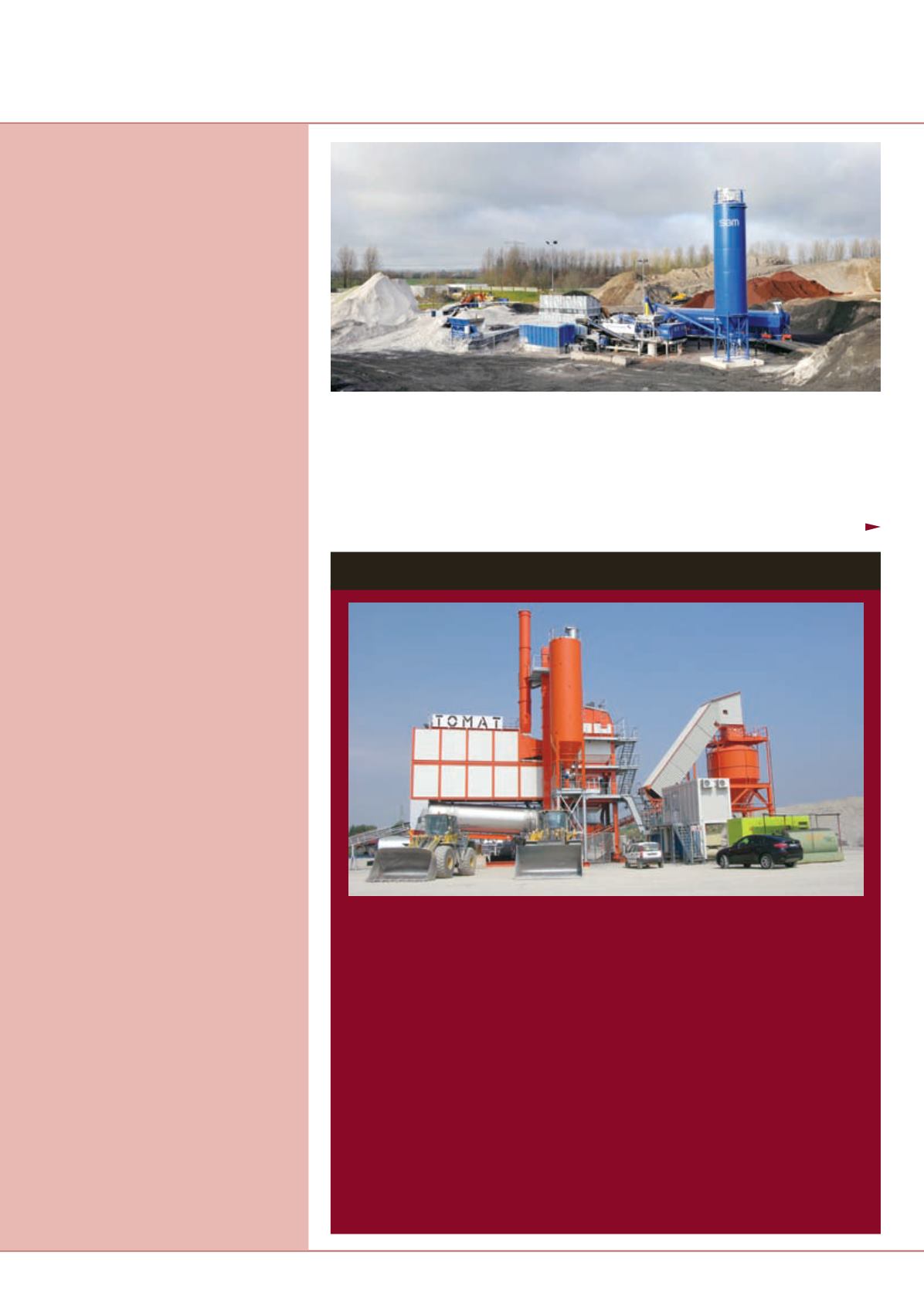
34
international
construction
Türkiye
Ekim
2013
English translation
Mikser teknolojilerinde yenilikler
Ekİpman dosyası
Concrete
On the concrete side, meanwhile, there has also
been a raft of new developments focussed on
increasing the efficiency of mixing technology,
and recycling is also a key issue affecting
developments in this sector. SBM, for instance,
has concentrated on bespoke solutions for its
customers, and developed a mobile concrete
batching plant, the Euromix 400C, for Dutch
contractor Van Gansewinkel.
The plant and has been designed to process
waste materials into concrete – the contractor
then stores this concrete mix on landfill sites.
Due to local regulations, certain loose waste
material is not allowed to be deposited directly
into landfill because it contains substances that
could leach into the surrounding environment.
By mixing the waste material with cement and
producing concrete, it binds the substance for
long-term storage as landfill.
The plant is required to work continuously with
an output of over 400 tonnes per hour and
comes with an independent generator. SBM
said the demands made on the control system
could not be met by conventional devices so
it developed a microprocessor control system
to control the plant by laptop and WLAN. This
system means that all data from the plant is
immediately available for further electronic data
processing, and allows the concrete mixing plant
to be supervised online.
To reduce service and maintenance works,
a specially designed high-pressure cleaning
system was also installed – reducing running
operation costs, according to SBM.
Meanwhile, a new plant from Rapid International
aims to offer higher production rates. The
Rapidmix 400CW incorporates a 1.2 m belt
conveyor between the aggregates hopper and
the continuous mixing chamber, and offers full
weighing options for all materials as well as
automated record keeping.
The first customer for the Rapidmix 400CW in
the USA was Texas-based Rollcon. The new
machine has been put to work on the latest
phase of the Port of Houston development
project, producing up to 400 tonnes of material
per hour.
Rapid International is also reporting interest
in its cement treated base (CTB) mixing
technology – a strong, frost-resistant road base.
CTB is comprised of native soils, gravels or
manufactured aggregates mixed with cement
and water in either a continuous flow or batch-
type mixing plant. The resulting material is said
to provide a weather resistant base which gains
strength with age.
Rapid International said CTB can also distribute
loads over a wider area, reducing the stresses on
the subgrade. It is typically used as a pavement
base for roads, streets, car parks, airports,
materials handling and storage areas.
Increasing the use of recycled pavement, and
reducing the amount of energy needed to
produce high quality asphalt and concrete will
continue to be key focusses for manufacturers
of mixing technology. It will be interesting to
see how the latest materials shape equipment
developments in the future.
amacında. Yeni ekipmanlar, gerek firmanın
kendi asfalt karışım tesisleriyle, gerekse rakip
markalarla uyum içinde çalışıyor.
Depolama siloları, yeni karıştırılmış
asfaltı bir taşıma bandı aracılığıyla alıp, tekrar
boşaltana kadar sabit sıcaklıkta tutuyor. Sabit
ve kendi kendini kuran farklı tasarımlar,
ekipmanın farklı asfalt tesisi tipleriyle birlikte
kullanılabilmesine olanak tanıyor ve müşterilere
çeşitli kapasite seçenekleri sunuluyor. Kendi
kendini kuran ADM modellerinde kapasite
değerleri 30 ile 75 ton arasında değişirken,
sabit silolarda bu aralık 100-300 tona çıkıyor.
Tüm modellerde, asfalt seviyesi fazla
SBM firması, Hollandalı yüklenici Van Gansewinkel için, taşınabilir ve bütünüyle kendi
kendine yeten bir beton santrali geliştirdi: Euromix 400C
Y
üklenici firma Tomat, İtalya’da
Villesse-Gorizia otoyol kavşağında
üçüncü bir şeridin inşası projesinde
bazalt agrega yerine Ecogravel ürününü
kullanarak, çevre üzerindeki olumsuz etkileri
azaltmak istedi. Ufalanmış cüruftan oluşan
Ecogravel, eleme işleminden geçirilerek
demir kalıntılarından arındırılıyor. Sonuçta,
doğal agrega üretimine göre çok daha az
çevresel etkiyle, önemli bir malzeme elde
ediliyor.
Asfalt tesisleri üreticisi Marini, aşınma
ve ufalanmalara karşı son derece dirençli
yapısı sayesinde, Ecogravel’in önemli
avantaj sağladığını belirtiyor. Ek olarak, ürün
atık malzemeden elde edilmesi de kelimenin
gerçek anlamıyla çöpten para kazanılması
anlamına geliyor.
Tomat, projede asfalt tesisi olarak 200
ton/saat kapasiteli Marini Top Tower 3000
modelini tercih etti. Otoyol koşullarında
kullanılmak üzere tasarlanmış
tesisin tüm parçaları,
soğuk agrega besleyiciler de dahil olmak
üzere, proje boyunca kolayca yeniden
konumlandırılabilen metal temeller
üzerinde bulunuyor. Tesisin bitüm ve
yakıt depolarında, bir arıza durumunda
dökülmeleri engellemek üzere taşma tankları
mevcut. Top Tower 3000’de, yalıtımlı sıcak
asfalt depolama tankları da standart olarak
sunuluyor.
Marini, projede altı aylık sürede 27.000
ton asfalt üretildiğini ve bu sayede Tomat’ın
projeyi zamanında teslim edebildiğini
vurguluyor.
Atıktan kar elde etmek


